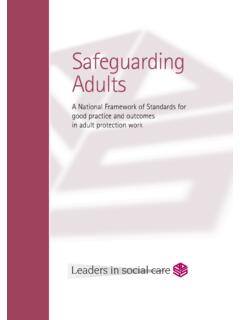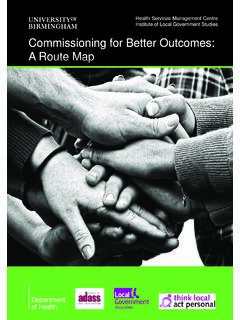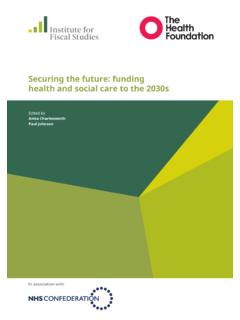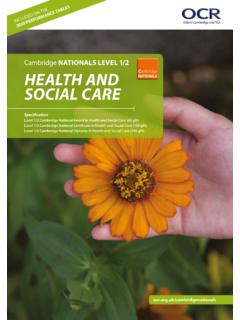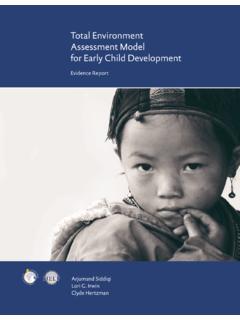Transcription of ADASS Budget survey
1 ADASS Budget survey 2017 1 ADASS : WHO WE ARE The Association of Directors of adults social Services is a charity. Our objectives include: Furthering comprehensive, equitable, social policies and plans which reflect and shape the economic and social environment of the time Furthering the interests of those who need social care services regardless of their backgrounds and status and Promoting high standards of social care services Our members are current and former directors of adult care or social services and their senior staff. PRESIDENT Margaret Willcox Gloucestershire County Council HONORARY SECRETARY Richard Webb North Yorkshire County Council HONORARY TREASURER David Pearson Nottinghamshire County Council VICE PRESIDENT Glen Garrod Lincolnshire County Council IMMEDIATE PAST PRESIDENT Ray James London Borough of Enfield REGIONAL LEAD Julie Ogley Central Bedfordshire Council POLICY LEAD Grainne Siggins London Borough of Newham 2 FOREWORD The annual ADASS Budget survey is an authoritative analysis of the state of adult social care finances drawn from the experiences of current leaders in adult social care .
2 It provides in-depth intelligence on how adult social care is responding to the multiple challenges of meeting increased expectations and need, whilst managing resources in an environment where Local Government funding is reducing, the provider and labour markets are fragile and the impact is affecting, and affected by, what is happening in the NHS. The Spring Budget recognised this and the significant and sustained reductions over a number of years in the funding available. An additional 2bn over three years, 1bn of which is available in 2017/18, enables councils to avoid what would have been a precipice in social care . All political parties recognised this in their 2017 election manifestos. The social care system will collapse if we do nothing about it, as there will be two million more people over the age of 75 within 10 years , the prime minister has said. (quoted on the BBC website).
3 The survey explores Directors views of how councils are trying to make very difficult decisions in relation to the growing numbers of people, with increasingly complex needs, requiring care and support, which is costing more, and with funding which isn t keeping pace. The survey data clearly sets out the concerns of councils in making increasingly difficult choices and their attempts to minimise impacts upon the front line services that are so valued and necessary for those needing them. In that the survey is widely used by others in the social care field, it also highlights how social care funding impacts on people needing care and support and their families and carers, providers and the NHS. The survey has been completed by 95% of councils and I am extremely grateful to all of my colleague Directors of Adult social Services in England for their support and contribution to this important work and to the ADASS Resources Leads, Jane Harris from Cordis Bright and the ADASS Staff Team for coordinating and producing this report.
4 Margaret Willcox President 3 Contents FOREWORD .. 2 Summary .. 4 1. CONTEXT .. 6 2. METHODOLOGY .. 8 3. FINDINGS .. 9 WHOLE COUNCIL BUDGETS AND SAVINGS .. 9 adult social care BUDGETS .. 10 Overview .. 10 Pressures associated with ASC budgets .. 11 adult social care SAVINGS .. 12 Impact of financial savings .. 16 PRESSURES .. 18 Additional pressure .. 18 PREVENTION .. 19 INCOME FROM FEES AND CHARGES .. 19 PROVIDER FEES .. 20 NATIONAL LIVING WAGE PRESSURES .. 24 PROVIDER FAILURE .. 25 BETTER care FUND (BCF) AND 25 4. OVERALL PROSPECTS FOR HEALTH AND social 31 5. CONCLUSIONS .. 32 4 Summary The ADASS Budget survey has tracked social care budgets and expenditure over a number of years. The 2016 survey set out key pressures and drew commentary, later echoed from a different perspective and a separate evidence base, relating to quality, that social care was approaching a tipping point.
5 This was recognised in the Spring Budget in the injection of additional funding of 2bn over three years, with 1bn in 2017/18, the Improved Better care Fund. This report sets out the results of the 2017 survey , conducted in May and June. The welcome additional funding and recognition takes place in the context of continuing increases in need, demand and costs. Without this, the planned savings would have caused irrevocable damage in relation to the levels of care for older and disabled people and their families and carers, to care markets and to the NHS. Need for social care , relating to increasing numbers of older and disabled people, increased by , the costs of the National Living Wage and other requirements rose by and there were increasing costs associated with delayed transfers of care from hospitals including fines for delays. Despite council protection, adult social care continues to have to make significant cuts.
6 The survey data shows that local authorities are prioritising adult social care in their Budget setting. The proportion of council spending on adult social care is set to increase from in 2016/17 to this year, despite councils having to make 8% cuts in overall budgets on top of a number of previous years reductions. Nevertheless, with further savings of 824m equating to 5% of net budgets - planned in 2017/18, total cumulative savings in adult social care since 2010 will amount to over 6bn by the end of March 2018. With a reported overspend of 366m against budgets for 2016/17, the pressure of which will roll forward, Directors are finding it increasingly difficult to implement planned cuts in practice. Only 31% of respondents are fully confident that planned savings for 2017/18 will be met and despite the additional funding which has been made available for adult social care , Directors confidence falls for future years, to a point where only 7% are fully confident that savings targets will be met in 2019/20.
7 ADASS has real concerns about the sustainability of the care market Directors have prioritised meeting adult social care needs (including counteracting previously planned savings) and support to the NHS in relation to planned expenditure of the additional 1bn Improved Better care Fund announced in the Spring Budget . DASSs cannot additionally plan to pay an hourly rate sufficient to make the care market particularly domiciliary care sustainable in the longer term and this will particularly be the case in some parts of the country. Directors continue to report the closure of services and handing back of contracts. Most strikingly, 74% of respondents believe that providers are facing quality challenges. 5 Support for and pressures from the NHS are increasing and the Better care Fund is not providing the additional resources social care needs Although the extra money from the adult social care precept and the Improved Better care Fund, it is important to note that except in very few areas the existing Better care Fund is providing no more resources in real terms than the existing NHS transfer to adult social care in 2014/15.
8 Both the NHS and adult social care are fragile systems, and there is increasing support going into planning and emerging pressures from the NHS, including fines for delayed transfers of care being levied, discussions about reductions to Continuing Healthcare payments, increased demand from people with very high needs not being admitted to hospital and pressure for healthcare activity to be undertaken by social care staff. The increasing care needs of working age adults are having an growing financial impact The fact that there are increasing numbers of older people continues to have an impact, and savings are being applied particularly to services for older people. However, the financial effect is now less than it is for the increasing care needs of younger adults with learning or physical disabilities or mental health problems. This year older people s services account for of the total of nearly reported pressures on adult social care budgets, with those people with learning disabilities accounting for a higher percentage at The remaining pressures are from people with physical disabilities or mental health needs.
9 Prevention is recognised as a major way of making savings, but it is impossible to prioritise Moving towards prevention and early intervention is the most important priority area for making savings, as it was in 2016/17. However, as budgets reduce it becomes harder for councils to manage the tension between prioritising statutory duties towards those with the greatest needs and investing in services that will prevent and reduce future needs. Spend on prevention forms of budgets this year: this is both a decrease as a proportion of Budget and a decrease in cash terms from the previous year. This raises the critical question of whether the investment in prevention is sufficient to realise the ambitions for its impact expressed by Directors. There is still an urgent need to find a long term sustainable solution for funding adult social care Only nine of the 138 Directors who responded feel at all optimistic about the future financial state of the local health and care economy in their own areas.
10 This is only marginally better than last year. 6 1. CONTEXT The Budget survey of 2016 set out the context and councils plans for the financial year 2016/17. The survey data pointed to a 1bn gap between the amount councils would need to spend to keep pace with demand and cost pressures and the funding available. Cost pressures relating to the increased numbers of older and disabled people needing care and support equated to 413m in 2016/17, of which only 81% had funding identified by councils ( 335m). In addition, the National Living Wage, affecting both direct council costs and increased provider fees, added an estimated cost of 520m, with a further 87m spending needed to administer Deprivation of Liberty Safeguards. The 2016 report noted that these pressures followed in the wake of five years of funding reductions totalling and representing 31% of real terms net budgets, tracked by previous Budget Surveys.



